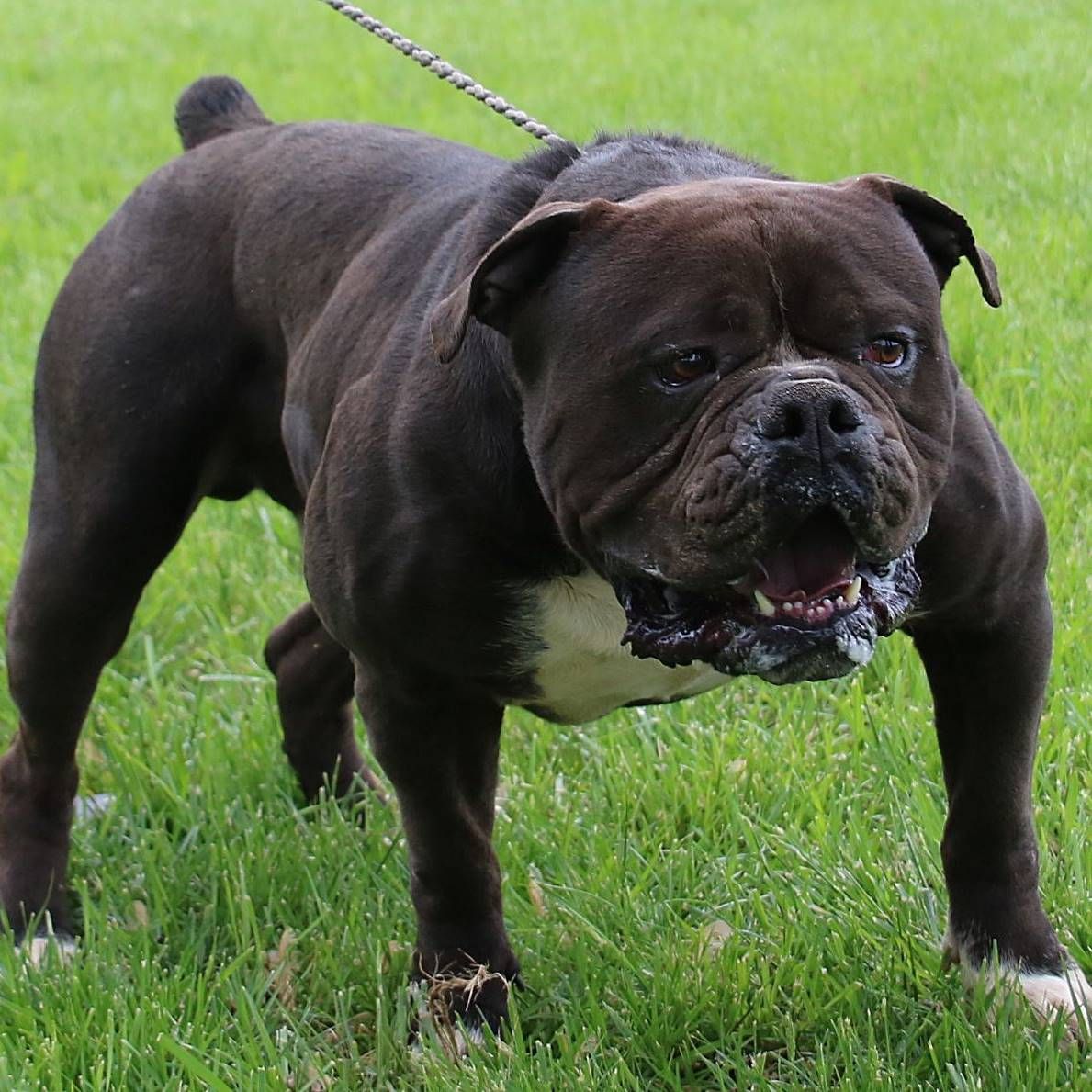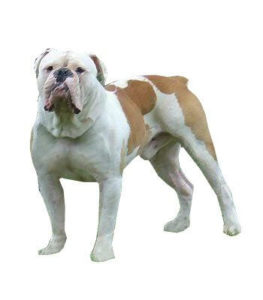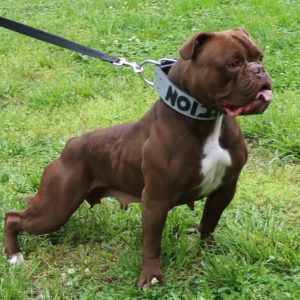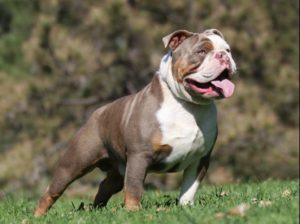Official Original O.E.B.A. Breed Standard
Re-Creation of original Bulldogge | This is the original Olde English Bulldogge Breed Standard.

APPEARANCE Medium sized dog. Powerfully built and showing great strength. Weight for males is 60 lbs. and up. Females 50 lbs. and up. Height at shoulders for males 17″ and up. Females 16″ and up. He should be alert, with a symmetrical, well proportioned body. The dog should be cobby, but have the appearance of an athlete.
TEMPERAMENT Friendly, but a fearless adversary to anyone who threatens his master or property. Unfriendliness to strangers isn’t a defect, although it’s unusual.

HEAD Large in proportion to body and square. Deeply sunken between eyes, extending up forehead. Moderately wrinkled. Jaw muscles large. Lower jaw turned up and protruding. Bite squared, but undershot. Large tusks. Eyes low and wide set. Forehead flat. Muzzle short and broad. Flews semi-pendulous. Ears may be either rose or button and should be set high and wide. Dewlap will have two folds.
BODY Neck should be short and nearly as wide as the head. Shoulders very broad and muscular. Front legs may be slightly bowed or straight. Ribs well rounded and chest wide and deep. Back short, slightly roached and strong. Belly well tucked up. Thighs very muscular. Rear legs neither pigeon-toed or cow-hocked. Tails must be straight.
COAT Short, close and medium fine.
COLOR Brindle of red, grey, or black. Brindle spots on white. Solid white. Fawn, red or black, solid or with white. Pink noses and pink skin around eyes are undesirable, but not a disqualification
GROUP Working
The Modern Olde English Bulldogge Breed Standard. (IOEBA)
General Description : The ideal Olde English Bulldogge is a loyal, courageous dog of medium size with a large powerful head and stout muscular body. Olde English Bulldogges are athletic and most importantly of very good health, males are free breeders and females are free whelpers. The Olde English Bulldogge is devoid of all breathing issues and is capable of enjoying outdoor activity without concern except in extreme heat or cold. The temperament is very stable and trustworthy making them a loyal companion, capable protector and the ultimate family member. Olde English Bulldogges thrive on pleasing their owners and are very trainable. The typical lifespan of an Olde English Bulldogge is between 10 and 14 years.
Head : Large and high, moderately sunken between the eyes (medial furrow). The circumference of the head should be equal to or greater than the dog’s height at the shoulder. A narrow head or one that appears too small for the body is a fault.
Ears : Rose ears set well on the sides of the head are preferred. Dropped ears are acceptable as long they are small, not “hound like”. Full pricked ears that stand up on top of the head should be considered a serious fault.
Muzzle : Broad, deep and short with moderate wrinkling. The bite is undershot with the bottom jaw turning up noticeably. Lower canines should not protrude. Muzzle too long (more than 3 inches), scissor bite or even bite are disqualifying faults. Muzzle should be no shorter than 1 ½”. Wry jaw is a disqualifying fault.
Eyes : Wide apart and of moderate size. Any color is acceptable. However, odd eyes (one dark, one blue or light) should be considered non preferred. Misshapen or bugged eyes are a serious fault. Lacking pigment around the eyes is undesirable. Crossed eyes or non-symmetrically shaped eyes are a disqualifying fault.

Nose : Broad with open nostrils (nares) with no sign of air restriction. The nose should not be pushed up between the eyes. From the stop to the end of the nose must be at least one and one half inches. The nose should be a solid color. Lacking pigment is a serious fault. A nose lacking all pigment is a disqualifying fault.
Neck : Short to medium in length and very muscular flowing into the shoulders and should not be set on the dog so it appears to stop at the shoulders.
Chest : Ribs should be well sprung (rounded) and the chest wide and deep. Depth of chest should be at least to the elbows. A hollow or narrow chest (slab sided) should be considered a serious fault.
Back : Males should appear square and balanced. Females should appear similar with consideration given for body length. Short with a very slight rise from the shoulders to a slight drop in the croup is preferred. A level back is acceptable as long as the tail does not come straight off the top of the back.
Shoulders : Shoulders should be well laid back with significant angulations to allow for good movement. Straight shoulders are a fault.
Legs : Forelegs should be straight and wide apart, neither bowing out nor turning in. There should be significant bone substance. Elbows should be relatively close to the body. Lacking bone and substance is very undesirable. Elbows that are loose or “fiddle fronts” are a disqualifying fault. “East / West” forelegs are a serious fault. Rear legs should exhibit significant bend of stifle so to allow for good movement. They should be well muscled. Straight or “posty” rear legs are a serious fault. Cow hocks are a disqualifying fault.
Movement : Dogs should have a balanced gait that drives off the rear and is complimented by reach allowing the dog to cover ground with a sense of power. Dogs should single track. Pacing or crabbing is a serious fault.
Feet : Round, tight both front and rear, and the pasterns should be strong. Weak pasterns and/or splayed feet are disqualifying faults.
Height : Males – 18 to 20 inches at the shoulder. Females – 17 to 19 inches at the shoulder.
Weight : Between 50 to 70 pounds for females and 65 to 85 pounds for males. Although height and weight above the standard is to be discouraged, there is no penalty as long as the dog is well proportioned, otherwise correct and balanced.

Color : Any color is acceptable with no preference of one over another.
Coat : The coat is short. A wavy coat or a long coat is a disqualifying fault; there should not be any signs of feathering on the legs, ears or neck area. OEBs with any sign of long or wavy coats are NOT to be registered.
Tail : A pump handle tail that naturally reaches the hock is preferred, screwed short or a docked tails are acceptable. The pump handle tail should be carried low and not over the back of the dog.
Temperament : Disposition should be outgoing and happy. While a watchful nature may be expected at home, human aggression without provocation is a disqualifying fault.